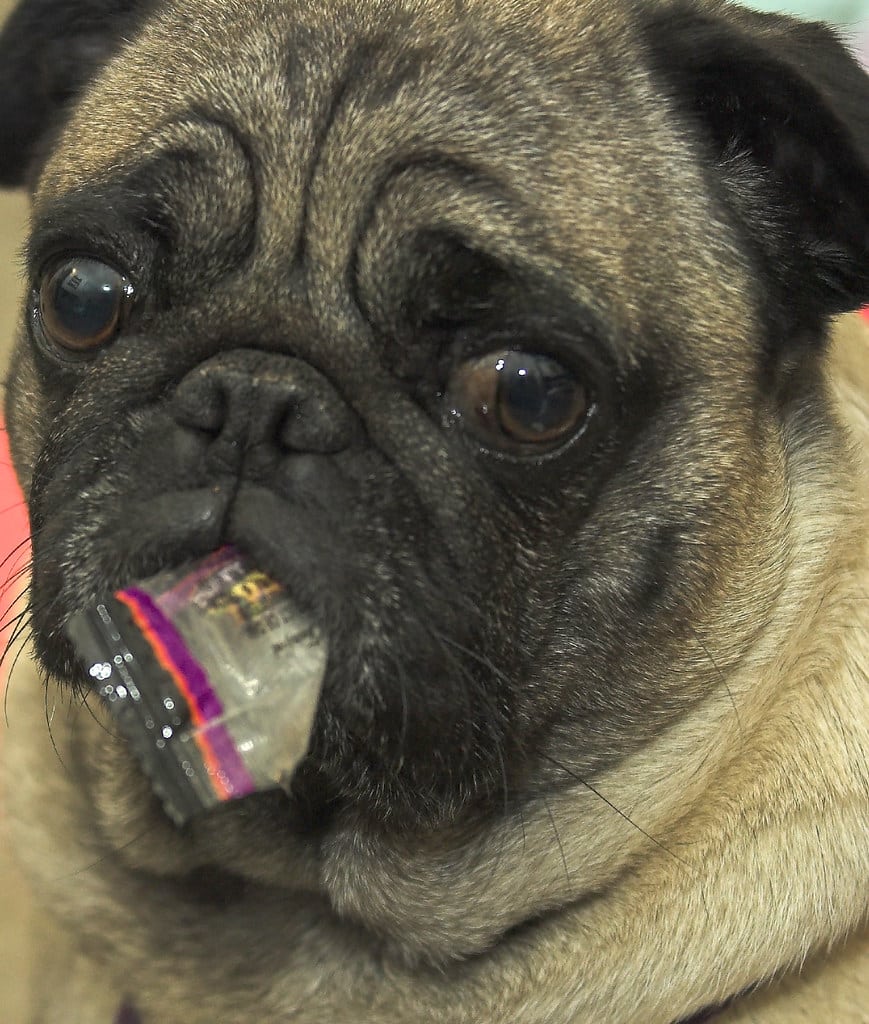Key Takeaways
- The toxic ingredient in chocolate is theobromine which dogs can’t metabolize normally.
- Pancreatitis is also a risk of ingesting chocolate due to its high fat and sugar content.
- Just 30g milk chocolate/kg body weight puts your pooch at risk of chocolate poisoning.
Hallowe’en is almost upon us, and fun-size chocolate candies are all around us. It’s not just us humans who can succumb to temptation. Our pooch pals might just sneak some, too if given the opportunity. This time of year, my clinic (and most others) see an uptick in dogs with chocolate poisoning.
Chocolate contains both caffeine and theobromine. The latter causes the main toxic effects we see. Affecting the heart, kidneys, and gastrointestinal system, chocolate is most definitely not Fido’s friend.
Dark chocolate is the most toxic, containing the most theobromine per gram of chocolate, but milk chocolate is also dangerous for furbabies.
If your dog has munched some milk chocolate, we recommend contacting the Pet Poison Helpline at 800-213-6680 and your local DVM for advice and an emergency appointment for your furbaby.
How much milk chocolate is toxic to dogs?
Milk chocolate contains up to 60mg theobromine/oz of chocolate; couple this with 6mg caffeine per oz, and the additional fat and sugar that makes it a tasty treat for us spells trouble for naughty puppies who sneak some.
While a couple of milk chocolate chips are unlikely to induce any signs in the average 10kg pooch, just 300g (20oz) of milk chocolate could put your dog at risk of poisoning.
There is also an increased risk of pancreatitis and tummy upsets with milk chocolates due to their high sugar and fat contents. There may also be other toxic ingredients in these tasty treats, such as macadamia nuts or xylitol.
Just 20oz of milk chocolate could spell chocolate poisoning for the average 10kg pooch. A good rule of thumb is to consult your veterinarian if your dog has eaten 1oz/kg body weight of milk chocolate. Always collect the wrapper, too, so your DVM can examine the other ingredients for any toxic substances.
What to do if my dog ate milk chocolate?
As with any potential poison ingestion, you should get the wrapper and weigh your dog to help you determine if your pooch has eaten a toxic dose of milk chocolate.
If your dog has eaten 1oz/kg of body weight of milk chocolate, then you should contact your DVM for an emergency appointment. If your dog has eaten just a tiny amount (eg, a couple of milk chocolate chips for most dogs), then it’s unlikely to cause poisoning but may cause tummy upsets.
Elderly pooches, cheeky puppies, and those with any underlying health conditions are at increased risk, and you should mention these health concerns to your DVM when discussing your dog’s risk of milk chocolate poisoning.
You should also contact the Pet Poison Helpline at 800-213-6680 to ensure that your dog hasn’t eaten any other toxic ingredient in its illicit snack.
If your dog has eaten less than the toxic amount of milk chocolate, your DVM will also want to know the other ingredients in the chocolate to ensure they weren’t inadvertently exposed to another toxic substance, such as macadamia nuts or raisins. Dogs that have eaten a toxic amount of milk chocolate need emergency treatment with hospitalization.
When to see a vet?
Unlike dark chocolate, milk chocolate has much lower levels of theobromine, so toxic ingestion would be 1oz/kg body weight. This doesn’t mean you can be complacent. Make sure to check the other ingredients to ensure your dog hasn’t been exposed to other toxic substances. Your veterinarian may also need to treat any other adverse effects, such as pancreatitis.
Even if your dog hasn’t eaten a toxic amount of milk chocolate, you should contact your DVM for advice on monitoring your dog for tummy upset or pancreatitis. This is particularly important if your dog is very young, old, or has other health conditions.
If your pooch has eaten a toxic amount of milk chocolate, then contact your DVM for an appointment for urgent treatment. Conversely, if your pooch hasn’t eaten a toxic amount of milk chocolate, they may still be at risk of gastrointestinal distress or pancreatitis and may need veterinary care in some instances.
What if my dog ate plenty of milk chocolate but seems fine?
Your pooch will feel completely fine for a few hours after eating milk chocolate. This is because it takes some time for the chocolate to be digested and absorbed into the bloodstream.
Once theobromine has been absorbed, the clinical signs start to show. Signs to watch out for are signs of gastrointestinal distress, restlessness, and panting.
In an ideal world, your dog should be seen by your veterinarian before signs start to show, but just because your dog isn’t showing signs yet doesn’t mean they’ve escaped trouble. As soon as you realize your dog has eaten some milk chocolate or they start to develop clinical signs, you should contact the Pet Poison Helpline and your DVM to determine the next steps.
Signs that my dog ate milk chocolate
Chocolate poisoning can take several hours to become evident as it takes some time for digestion and absorption of theobromine (and the fats and sugars) to be absorbed.
Clinical signs to watch out for are restlessness, gastrointestinal distress, and increased thirst and urination, among others listed below.
Luckily chocolate poisoning is rarely fatal however severe cases can show signs of seizures, muscle tremors, and potentially even permanent heart damage.
The common signs of chocolate toxicity are:
- Vomiting
- Diarrhea
- Increased thirst
- Increased urination
- Restlessness
- Panting
If your fur baby shows any of the above-listed signs after eating milk chocolate, then you should contact your emergency DVM and the Pet Poison Helpline to determine the next steps in their care. Don’t forget to have the wrapper to hand so you can assess how much they may have eaten and if there were possibly any other toxic ingredients in the product.
What happens to dogs that eat milk chocolate?
The rapid absorption of theobromine during digestion means that it just takes a few hours for signs of chocolate toxicity to become evident. Theobromine is unusual in that it persists inside your dog’s bloodstream for extended periods of time and can even be reabsorbed back into the blood from your pooch’s bladder.
The primary toxic ingredient in milk chocolate is theobromine. Theobromine affects the heart, gastrointestinal and nervous systems causing the typical signs listed above that, include vomiting, diarrhea, racing heart rate, incoordination, and increased urination. Milk chocolate is also high in fat and sugar, which can cause pancreatitis (inflammation of the pancreas), which is an extremely painful condition that can cause vomiting, diarrhea, abdominal pain, and restlessness.
Why is milk chocolate toxic to dogs?
There are a few reasons that milk chocolate is toxic to our canine furiends: theobromine, caffeine, and high-fat content.
Fat isn’t toxic in itself, but it can cause significant adverse effects in our canine patients. Theobromine is the most toxic and acts as a diuretic, muscle relaxant, and cardiac stimulant. This translates to increased thirst and urination, and racing heart rates for our dogs.
Caffeine also affects the heart causing elevated blood pressure and can even cause cardiac arrhythmias, which can be dangerous for our dogs. There’s much less caffeine than theobromine in milk chocolate, though, so it’s not as high on the list of concerns for dogs.
Containing both theobromine and caffeine, milk chocolate is toxic due to the effects of these chemicals. These effects include racing heart rates, elevated blood pressure, and increased urination and thirst. Coupled with painful gastrointestinal signs, including vomiting and diarrhea, milk chocolate is not a tasty treat for our fur babies.
How do vets treat milk chocolate poisoning?
As with most toxins, the treatment for milk chocolate ingestion will vary with the amount of chocolate eaten. It will also depend on if there are other toxic ingredients in the chocolate candy.
If a toxic amount of milk chocolate were ingested within the preceding two hours, your veterinarian would begin with decontamination, i.e., inducing vomiting and then administering activated charcoal to minimize absorption across the small intestine.
Antacid and other gastroprotective medications will help with the other gastrointestinal signs. Aggressive supportive treatments will also be required. These include intravenous fluid therapy, anti-inflammatory medications, and possibly even a urinary catheter to encourage the removal of theobromine in the urine and prevent its reabsorption from the bladder.
Rigorous monitoring of your dog’s heart and nervous system is also essential to determine if your dog needs to be administered any cardiac or anti-convulsant medications.
Induced vomiting followed by administration of activated charcoal are the first steps your veterinarian will take if your pooch ate the offending treat within 2 hours of their presentation. Intravenous fluids and many trips outdoors to pee will promote the removal of theobromine from the bladder. Hospitalization may be required to monitor your dog’s cardiac function.
Final Woof
During this time of year, chocolate poisoning is more prevalent in our precious pooches, and it’s a true emergency. If your dog has eaten some milk chocolate, you should check the wrapper and contact the Pet Poison Helpline and your veterinarian to ascertain if they’ve eaten a toxic dose or if there were other toxic ingredients in the candy bar.
If your dog has previously had pancreatitis or other health conditions, then he may be at even more risk of adverse effects even if they’ve not eaten a toxic dose.
Luckily chocolate poisoning is rarely fatal, and mild poisonings, such as those with tummy upsets, tend to have an excellent prognosis. Severe poisonings, such as those with heart failure or seizures, carry a much poorer prognosis for recovery, so the sooner your dog starts treatment, the much better his chances are for a complete and rapid recovery.


